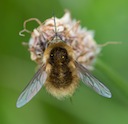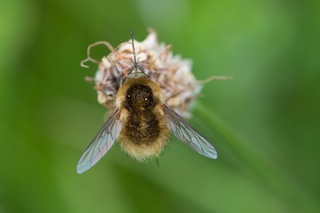 The Western Bee-fly is a fairly rare species in the UK – it has been spotted on The Lizard, both near Kennack and at Poltesco.
The Western Bee-fly is a fairly rare species in the UK – it has been spotted on The Lizard, both near Kennack and at Poltesco.
Photo: Tony Blunden
Scientific name: Bombylius canescens
Other common names: Beewhal (East Anglian local name for bee-flies more generally)
What to look for:
- Colouring and other features: Tiny, furry-looking insect with unmarked wings, black bristles behind the eyes, dark upper leg segment (femora), long proboscis.
- Size: Length, 6.5 to 7.5 mm, not including the proboscis.
- When: Most likely to be seen from June to July, but can also be spotted in May and August.
- Where: Open habitats with plenty of flowering plants.
- Similar species: Other Bombylius species, especially the Heath Bee-fly which also has unmarked wings (the other two British species have wing markings), but is generally paler.
 The long rigid proboscis of a bee-fly can look a little intimidating, but there’s no need to worry about getting stung or bitten. These intriguing insects are harmless to humans, and the proboscis is used for taking nectar from flowers.
The long rigid proboscis of a bee-fly can look a little intimidating, but there’s no need to worry about getting stung or bitten. These intriguing insects are harmless to humans, and the proboscis is used for taking nectar from flowers.
There are four native species of bee-fly in the genus Bombylius: the Dark-edged (or Common) Bee-fly (the one most commonly seen), the Dotted Bee-fly, the Heath Bee-fly (found mainly in Dorset) and the Western Bee-fly, a nationally scarce species (southern Wales and the western counties of England, including Cornwall).
Like other Bee-flies in the genus Bombylius, the Western Bee-fly is parasitic on the eggs and larvae of solitary bees in its larval stages.
Did you know…?
…Species in the genus Bombylius can be found across the globe. There are some 40 European species and over 50 species in North America.
More information and references:
Harvey, M.C. (compiler), 2014. Identifying bee-flies in genus Bombylius. Soldierflies and Allies Recording Scheme, Biological Records Centre.
Published: June 2015
Author: Amanda Scott
Photo: Tony Blunden
